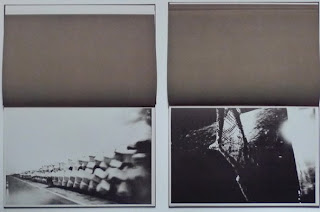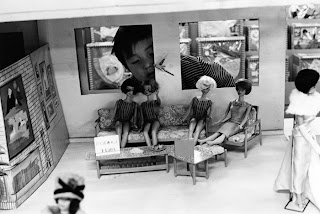By Thomas Beller
Experiencing the city can be like a dream; its logic can suddenly bend into contorted shapes that seem to scream out for citation and correction. Everyone around walks on, busy, involved, oblivious to the absurdity that just caught the eye.
The city is a place where the self is confronted most brutally with the other, and where it is also most detached from it. The city is history, and it is an Orwellian “double think” where history is abolished quickly and without notation. In the city, “time challenges time, time clashes with time: habits and values carry over beyond the living group, streaking with different strata of time the character of any single generation. Layer upon layer, past times preserve themselves in the city until life itself is finally threatened with suffocation.”
This quote, culled from Lewis Mumford’s “The Culture of Cities, inaugurates Invisible City a book of photographs by Ken Schles. Schles’ subject matter is the nooks and crannies of the urban landscape in which people’s lives take place. The landscape which Schles’ photographs charter is visually reminiscent of the Lower East Side, as are the young, faintly hip people who populate it, almost inadvertently. But the book is not site specific; there are no captions explanation, or credits to accompany the photographs. The intent is clearly to use urban experience as metaphor for a more general condition of people today, particularly young people in the photographs youthful sensuality coexists with despair.
The images in Invisible City are dark and grainy. They are all black and white, and it is the black and white that does not forgive, that doesn’t console the absence of color with sharply delineated form. Schles’ pictures turn, page after page, in mesmerizing succession, and though the pictures do not tell a particular story, they form an intense narrative each one contextualizing the image that came before and that comes after.





The scenes depicted vary from action shot (two lovers kiss in a bar, a crowd forms as a tenement goes up in flames in the distance, a little boy in a shopping cart points a toy gun at the viewer with a murderously serious expression) to still lifes (an abandoned baby carriage in an angular hallway, windowsill tulips juxtaposed against a garbage-strewn back alley). The composition of each image has its own internal tension. The light in these photographs is ethereal and glowing, making every bare light bulb explode into a cascading flare, an effect achieved by using a hand-held camera for long exposures in low light situations.
The grainy and often blurred photographs give inanimate objects like a gutted building, a strange sense of motion. The visual activity that the eye senses is punning on the motion of the picture’s subject: that of decay. Schles has a canny eye for subverting what appears to be playful innocence. The world, his pictures suggest, is a particular thing, but not hat we think it is. As he put it, the photographs “capture moments of raw truth in the midst of deception.”
It is in this manner that Invisible City takes off, without fanfare into metaphor. By playing down the presence of the perceiver in these photographs and avoiding solipsistic documentary. Schles allows the themes of subjectivity, memory, temporality and the self to rise without hindrance.
The individual in the city seems like a tender walnut unshelled, buffeted, and somehow surviving, if only barely, the vicissitudes of his surroundings. All around there is evidence of a struggle on the part of every individual to make their lives livable—little futile gestures of people trying to create a space for themselves. The remnants of these attempts are always more pitiful m poor neighborhoods not because they are more futile but because each brush stroke is visible; poor people have as material to make their lives better, the detritus of the rest of society.











his is captured in several different instances by Schles and on several deferent levels In one photograph a dilapidated wooden chair that has lost its back sits alone, uninhabited in a tiled building lobby, lit only by an overhead light whose glow contrasts sharply with the scaled tiles beneath it. The chair is empty, but its presence suggests an attempt. This was not only used by one individual but perhaps even coveted by others who were present at the time. Its value, like a futures commodity on Wall Street, is ethereal subject entirely to the laws of supply and demand.
There is no sentiment in these documentations of tenuousness. In another photo, fireworks on the Fourth of July explode in the distance people, mostly black stand on the vacated FDR Drive to watch. Three sisters, whose succession of skinny legs forms a remarkable formal composition, stand on the center divider to get a better look. But the energy of festivity is too far away. The girls’ body language suggests that they are peering over a tall hedge to look at a party that they are not invited to. The languid street energy and hot summer night is the foreground, dominating.
Fear and tenderness are at risk of being counterfeited before they even rise to consciousness but pain is a different story. The starkness of the pictures; their embracing blur; the nugget of joy that exist on the sheer force of desire; the schizophrenia of mood that quivers on each page and then modulates into an unrecognizable entity as the page turns-all speak of pain. The entire spectrum, from the certainty of loneliness to the fragility of happiness is there on the counter with the cigarette and the bag of Cafe Bustelo and the bottle of Bayer lying on its side It’s a topography d existence that Schles makes you walk through, without a compass. But arrivals are all the more pleasant when earned, and Invisible City ferments with a little time and looking until it is intoxicating, like wine. One can’t finish with Invisible City: it gets in your system and echoes there, the sound of humanity tapping on a thick cell wall.
(1989 April Issue of Splash – brought to ASX in partnership with Ken Schles & Thomas Beller)
This book is available for download on your iPad with iBooks or on your computer with iTunes


















































